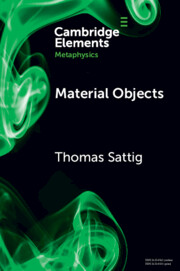References
Akiba, K. 2000: ‘Vagueness as a Modality’, Philosophical Quarterly, 50: 359–70.
Akiba, K. & Abasnezhad, A. (eds.) 2014: Vague Objects and Vague Identity: New Essays on Ontoc Vagueness. Berlin: Springer.
Armstrong, D. M. 1980: ‘Identity through Time’, in van Inwagen, P. (ed.), Time and Cause: Essays Presented to Richard Taylor, Dordrecht: D. Reidel, pp. 67–78.
Baker, L. R. 2007: The Metaphysics of Everyday Life: An Essay in Practical Realism. Cambridge: Cambridge University Press.
Baker, L. R. 2000: Persons and Bodies: A Constitution View. Cambridge: Cambridge University Press.
Balashov, Y. 2010: Persistence and Spacetime. Oxford: Oxford University Press.
Barnes, E. & Williams, J. R. G. 2011: ‘A Theory of Metaphysical Indeterminacy’, Oxford Studies in Metaphysics, 6: 103–48.
Bennett, K. 2017: Making Things Up. Oxford: Oxford University Press.
Bennett, K. 2013: ‘Having a Part Twice Over’, Australasian Journal of Philosophy, 91: 83–103.
Bennett, K. 2004: ‘Spatio-Temporal Coincidence and the Grounding Problem’, Philosophical Studies, 118: 339–71.
Bohn, E. D. 2012: ‘Monism, Emergence, and Plural Logic’, Erkenntnis, 76: 211–23.
Bostrom, N. 2003: ‘Are You Living in a Computer Simulation?’, Philosophical Quarterly, 53: 243–55.
Brenner, A. 2018: ‘Science and the Special Composition Question’, Synthese, 195: 657–78.
Burke, X. 1994: ‘Preserving the Principle of One Object to a Place: A Novel Account of the Relations among Objects, Sorts, Sortals, and Persistence Conditions’, Philosophy and Phenomenological Research, 54: 591–624.
Butterfield, J. 2005: ‘On the Persistence of Particles’, Foundations of Physics, 35: 233–69.
Calosi, C. 2014: ‘Quantum Mechanics and Priority Monism’, Synthese, 191: 915–28.
Calosi, C. & Costa, D. 2015: ‘Multilocation, Fusion and Confusions’, Philosophia, 43: 25–33.
Calosi, C. & Morganti, M. 2021: ‘Interpreting Quantum Entanglement: Steps towards Coherentist Quantum Mechanics’, British Journal for the Philosophy of Science, 72: 865–91.
Calosi, C. & Morganti, M. 2016: ‘Humean Supervenience, Composition as Identity and Quantum Wholes’, Erkenntnis, 81: 1173–94.
Carmichael, C. 2015: ‘Toward a Commonsense Answer to the Special Composition Question’, Australasian Journal of Philosophy, 93: 475–90.
Costa, D. 2017: ‘The Transcendentist Theory of Persistence’, Journal of Philosophy, 114: 57–75.
Cotnoir, A. J. & Baxter, D. L. M. (eds.) 2014: Composition as Identity. Oxford: Oxford University Press.
Cotnoir, A. J. & Varzi, A. C. 2021: Mereology. Oxford: Oxford University Press.
deRosset, L. 2011: ‘What Is the Grounding Problem?’, Philosophical Studies, 156: 173–97.
Donnelly, M. 2010: ‘Parthood and Multi-location’, Oxford Studies in Metaphysics, 5: 203–43.
Eagle, A. 2016: ‘Location and Perdurance’, Oxford Studies in Metaphysics, 5: 53–94.
Eddon, M. 2010: ‘Three Arguments from Temporary Intrinsics’, Philosophy and Phenomenological Research, 81: 605–17.
Einstein, A., Podolsky, B., & Rosen, N. 1935: ‘Can Quantum-Mechanical Descriptions of Reality Be Considered Complete?’, Physical Review, 47: 777–80.
Eklund, M. 2008: ‘The Picture of Reality as an Amorphous Lump’, in Sider, T., Hawthorne, J., & Zimmerman, D. W. (eds.), Contemporary Debates in Metaphysics, Blackwell, pp. 382–96.
Evnine, S. J. 2016: Making Objects and Events: A Hylomorphic Theory of Artifacts, Actions, and Organisms. Oxford: Oxford University Press.
Fine, K. 2010: ‘Towards a Theory of Part’, Journal of Philosophy, 107: 559–89.
Fine, K. 2008: ‘Coincidence and Form’, Proceedings of the Aristotelian Society, 82: 101–18.
Fine, K. 2003: ‘The Non-identity of a Material Thing and Its Matter’, Mind, 112: 195–234.
Fine, K. 2000: ‘A Counter-example to Locke’s Thesis’, Monist, 83: 357–61.
Fine, K. 1999: ‘Things and Their Parts’, Midwest Studies in Philosophy, 23: 61–74.
Fine, K. 1975: ‘Vagueness, Truth and Logic’, Synthese, 30: 265–300.
Gallois, A. 2003: Occasions of Identity. Oxford: Oxford University Press.
Geach, P. 1980: Reference and Generality. Ithaca, NY: Cornell University Press.
Gibbard, A. 1975: ‘Contingent Identity’, Journal of Philosophical Logic, 4: 187–221.
Gibson, I. & Pooley, O. 2006: ‘Relativistic Persistence’, Philosophical Perspectives, 20: 157–98.
Gilmore, C. 2008: ‘Persistence and Location in Relativistic Spacetime’, Philosophy Compass, 3/6: 1224–54.
Gilmore, C. 2006: ‘Where in the Relativistic World Are We?’, Philosophical Perspectives, 20: 199–236.
Haslanger, S. 1989: ‘Persistence, Change, and Explanation’, Philosophical Studies, 56: 1–18.
Hawley, K. 2002: ‘Vagueness and Existence’, Proceedings of the Aristotelian Society, 102: 125–40.
Hawley, K. 2001: How Things Persist. Oxford: Oxford University Press.
Hawthorne, J. 2009: ‘Superficialism in Ontology’, in Manley, D., Chalmers, D. J., & Wasserman, R. (eds.), Metametaphysics: New Essays on the Foundations of Ontology, Oxford University Press, pp. 213–30.
Hawthorne, J. 2006: Metaphysical Essays. Oxford: Oxford University Press.
Heller, M. 1991: The Ontology of Physical Objects: Four-Dimensional Hunks of Matter. New York: Cambridge University Press.
Hestevold, H. S. 1981: ‘Conjoining’, Philosophy and Phenomenological Research, 41: 371–85.
Hinchliff, M. 1996: ‘The Puzzle of Change’, Philosophical Perspectives, 10: 119–36.
Hirsch, E. 2005: ‘Physical-Object Ontology, Verbal Disputes, and Common Sense’, Philosophy and Phenomenological Research, 70: 67–97.
Hirsch, E. 2002a: ‘Against Revisionary Ontology’, Philosophical Topics, 30: 103–27.
Hirsch, E. 2002b: ‘Quantifier Variance and Realism’, Philosophical Issues, 12: 51–73.
Hofweber, T. 2016: Ontology and the Ambitions of Metaphysics. Oxford: Oxford University Press.
Hofweber, T. 2009: ‘The Meta-problem of Change’, Noûs, 43: 286–314.
Hofweber, T. & Velleman, J. D. 2010: ‘How to Endure’, Philosophical Quarterly, 61: 37–57.
Ismael, J. & Schaffer, J. 2020: ‘Quantum Holism: Nonseparability as Common Ground’, Synthese, 197: 4131–60.
Johnston, M. 1987: ‘Human Beings’, Journal of Philosophy, 84: 59–83.
Jubien, M. 2001: ‘Thinking about Things’, Philosophical Perspectives, 15: 1–15.
Korman, D. 2015: Objects: Nothing Out of the Ordinary. Oxford: Oxford University Press.
Korman, D. 2010: ‘The Argument from Vagueness’, Philosophy Compass, 5/10: 891–901.
Korman, D. 2008: ‘Unrestricted Composition and Restricted Quantification’, Philosophical Studies, 140: 319–34.
Korman, D. & Carmichael, , C. 2017: ‘What Do the Fol Think about Composition and Does It Matter?’, in Rose, D. (ed.), Experimental Metaphysics, Bloomsbury Academic, pp. 187–206.
Koslicki, K. 2018: Form, Matter, Substance. Oxford: Oxford University Press.
Koslicki, K. 2008: The Structure of Objects. Oxford: Oxford University Press.
Kovacs, D. M. 2020: ‘Constitution and Dependence’, Journal of Philosophy, 117: 150–77.
Langford, S. & Ramachandran, M. 2013: ‘The Products of Fission, Fusion, and Teletransportation: An Occasional Identity Theorist’s Perspective’, Australasian Journal of Philosophy, 91: 105–17.
Lewis, D. 1999: ‘Zimmerman and the Spinning Sphere’, Australasian Journal of Philosophy, 77: 209–12.
Lewis, D. 1993: ‘Many, But Almost One’, in Campbell, K., Bacon, J., & Reinhardt, L. (eds.), Ontology, Causality, and Mind: Essays in Honour of D. M. Armstrong, Cambridge University Press, pp. 23–38.
Lewis, D. 1988: ‘Rearrangement of Particles: Reply to Lowe’, Analysis, 48: 65–72.
Lewis, D. 1986: On the Plurality of Worlds. Oxford: Blackwell.
Lewis, D. 1983a: ‘Survival and Identity’, in his Philosophical Papers, Vol. 1, Oxford University Press, pp. 55–77.
Lewis, D. 1983b: ‘Counterparts of Persons and Their Bodies’, in his Philosophical Papers, Vol. 1, Oxford University Press, pp. 203–11.
Locke, J. 1690/1975: An Essay Concerning Human Understanding, ed. Nidditch, P. H.. Oxford: Clarendon Press.
Markosian, N. 2008: ‘Restricted Composition’, in Sider, T., Hawthorne, J., & Zimmerman, D. W. (eds.), Contemporary Debates in Metaphysics, Blackwell, pp. 341–63.
McDaniel, K. 2017: The Fragmentation of Being. Oxford: Oxford University Press.
McGee, V. & McLaughlin, B. 2000: ‘The Lessons of the Many’, Philosophical Topics, 28: 129–51.
McKenzie, K. & Muller, F. A. 2018: ‘Bound States and the Special Composition Question’, in M. Massimi, J.-W. Romejin, & G. Schurz (eds.), EPSA 15 Selected Papers, Springer, pp. 233–42.
McKinnon, N. 2002: ‘Supervaluations and the Problem of the Many’, Philosophical Quartely, 52: 320–39.
Merricks, T. 2001: Objects and Persons. New York: Oxford University Press.
Nozick, R. 1981: Philosophical Explanations. Oxford: Clarendon Press.
O’Leary-Hawthorne, J. & Cortens, A. 1995: ‘Towards Ontological Nihilism’, Philosophical Studies, 79: 143–65.
Parfit, D. 1984: Reasons and Persons. Oxford: Clarendon Press.
Parsons, J. 2007: ‘Theories of Location’, Oxford Studies in Metaphysics, 3: 201–32.
Parsons, T. 2000: Indeterminate Identity. Oxford: Oxford University Press.
Pooley, O. 2019: ‘There is Invariant Four-Dimensional Stuff’, unpublished manuscript, University of Oxford.
Putnam, H. 2004: Ethics without Ontology. Cambridge, MA: Harvard University Press.
Putnam, H. 1987: The Many Faces of Realism. La Salle: Open Court.
Rea, M. 2000: ‘Constitution and Kind Membership’, Philosophical Studies, 97: 169–93.
Rea, M. 1997: ‘Supervenience and Co-Location’, American Philosophical Quarterly, 34: 367–75.
Rose, D. & Schaffer, J. 2017: ‘Folk Mereology is Teleological’, Noûs, 51: 238–70.
Rosen, G. & Dorr, C. 2002: ‘Composition as a Fiction’, in Gale, R. (ed.), The Blackwell Compaion to Metaphysics, Blackwell, pp. 151–74.
Saenz, N. B. 2015: ‘A Grounding Solution to the Grounding Problem’, Philosophical Studies, 172: 2193–214.
Sattig, T. 2019: ‘Part, Slot, Ground: Foundations for Neo-Aristotelian Mereology’, Synthese, 198: 2735–49.
Sattig, T. 2017: ‘Metaphysical Ambitions in the Ontology of Objects’, Philosophy and Phenomenological Research, 94: 481–87.
Sattig, T. 2015: The Double Lives of Objects: An Essay in the Metaphysics of the Ordinary World. Oxford: Oxford University Press.
Sattig, T. 2010: ‘Compatibilism about Coincidence’, Philosophical Review, 119: 273–313.
Sattig, T. 2006: The Language and Reality of Time. Oxford: Oxford University Press.
Schaffer, J. 2009: ‘On What Grounds What’, in Manley, D., Chalmers, D. J., & Wasserman, R. (eds.), Metametaphysics: New Essays on the Foundations of Ontology, Oxford University Press, pp. 347–83.
Shoemaker, S. 1963: Self-Knowledge and Self-Identity. Ithaca, NY: Cornell University Press.
Sider, T. 2013: ‘Against Parthood’, Oxford Studies in Metaphysics, 8: 237–93.
Sider, T. 2011: Writing the Book of the World. Oxford: Oxford University Press.
Sider, T. 2001: Four-Dimensionalism: Ontology of Persistence and Time. Oxford: Oxford University Press.
Sutton, C. S. 2012: ‘Colocated Objects, Tally-Ho: A Solution to the Grounding Problem’, Mind, 121: 703–30.
Teller, P. 1986: ‘Relational Holism and Quantum Mechanics’, British Journal for the Philosophy of Science, 37: 71–81.
Thomasson, A. 2007: Ordinary Objects. Oxford: Oxford University Press.
Thomson, J. J. 1998: ‘The Statue and the Clay’, Noûs, 32: 149–73.
Turner, J. 2011: ‘Ontological Nihilism’, Oxford Studies in Metaphysics, 6: 3–54.
Turner, J. 2010: ‘Ontological Pluralism’, Journal of Philosophy, 107: 5–34.
Unger, P. 1980: ‘The Problem of the Many’, Midwest Studies in Philosophy, 5: 411–67.
Unger, P. 1979: ‘There Are No Ordinary Things’, Synthese, 41: 117–54.
van Inwagen, P. 1990: Material Beings. Ithaca, NY: Cornell University Press.
Wallace, M. 2011a: ‘Composition as Identity: Part 1’, Philosophy Compass, 6/11: 804–16.
Wallace, M. 2011b: ‘Composition as Identity: Part 2’, Philosophy Compass, 6/11: 817–27.
Wasserman, R. 2016: ‘Theories of Persistence’, Philosophical Studies, 173: 243–50.
Wiggins, D. 1967: Identity and Spatio-Temporal Continuity. Oxford: Blackwell.
Williams, B. A. O. 1956: ‘Personal Identity and Individuation’, Proceedings of the Aristotelian Society, 57: 229–52.
Zimmerman, D. 1999: ‘One Really Big Liquid Sphere: Reply to Lewis’, Australasian Journal of Philosophy, 77: 213–15.
Zimmerman, D. 1998: ‘Temporal Parts and Supervenient Causation: The Incompatibility of Two Humean Doctrines’, Australasian Journal of Philosophy, 76: 265–88.
Zimmerman, D. 1997: ‘Immanent Causation’, Philosophical Perspectives, 11: 433–71.
Zimmerman, D. 1995: ‘Theories of Masses and Problems of Constitution’, Philosophical Review, 104: 53–110.



